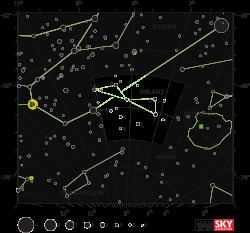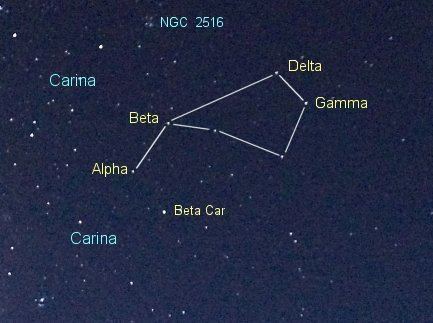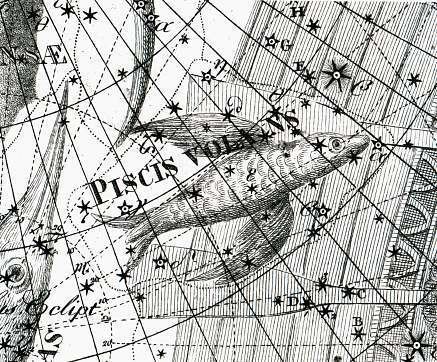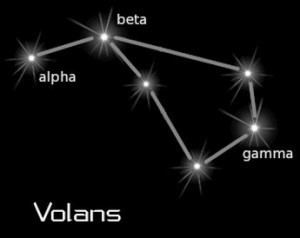Abbreviation Vol Declination −70 Main stars 6 Messier object 0 | Genitive Volantis Right ascension 8 Bayer/Flamsteed designation 12 | |
Pronunciation /ˈvoʊlænz/,genitive /vɒˈlæntᵻs/ Similar Mensa, Pictor, Chamaeleon, Dorado, Apus | ||
Volans constellation
Volans is a constellation in the southern sky. It represents a flying fish; its name is a shortened form of its original name, Piscis Volans. Volans was one of twelve constellations created by Petrus Plancius from the observations of Pieter Dirkszoon Keyser and Frederick de Houtman and it first appeared on a 35-cm diameter celestial globe published in 1597 (or 1598) in Amsterdam by Plancius with Jodocus Hondius. The first depiction of this constellation in a celestial atlas was in Johann Bayer's Uranometria of 1603.
Contents

History

Volans is one of the 12 constellations that were introduced by the Dutch navigators Pieter Dirkszoon Keyser and Frederick de Houtman in the late 16th century. It was first depicted on Petrus Plancius’ globe in 1598. Plancius called the constellation Vliegendenvis (flying fish).

In 1603, Johann Bayer included the constellation in his star atlas Uranometria under the name Piscis Volans, the flying fish. John Herschel proposed shrinking the name to one word in 1844, noting that Lacaille himself had abbreviated his constellations thus on occasion. This was universally adopted.

Volans represents a type of tropical fish that can jump out of the water and glide through the air on wings. In early celestial maps, the flying fish was often depicted as accompanying the ship Argo Navis, and being chased by the predatory fish represented by the adjoining constellation Dorado.
Stars
There are two double stars within the constellation which can be observed using a small telescope, Gamma Volantis and Epsilon Volantis, along with two galaxies which may be more difficult to see clearly, NGC 2442 and NGC 2434. The magnitudes of the Gamma Volantis stars are fourth and sixth, and of Epsilon Volantis fourth and eighth.
HD 76700 is a sunlike star some 195 light-years distant that has been found to have a planet.
Deep-sky objects
Volans has several deep-sky objects within its borders.
The Lindsay-Shapley ring, also categorized as AM0644-741, is a ring galaxy located 300 million light-years from Earth. Named for its discoverers, the Lindsay-Shapley ring was found near the Large Magellanic Cloud in 1960. Like the Cartwheel Galaxy in Sculptor, the unusual shape of this galaxy results from a collision many millions of years ago. The blue ring, 150,000 light-years in diameter, was formed when a shock wave from the collision created a ring of hot blue stars; the yellow core is an amalgamation of the progenitors' cores. NGC 2442, an intermediate-spiral galaxy, is also located in this constellation, with a distance of 50 million light-years from Earth.
